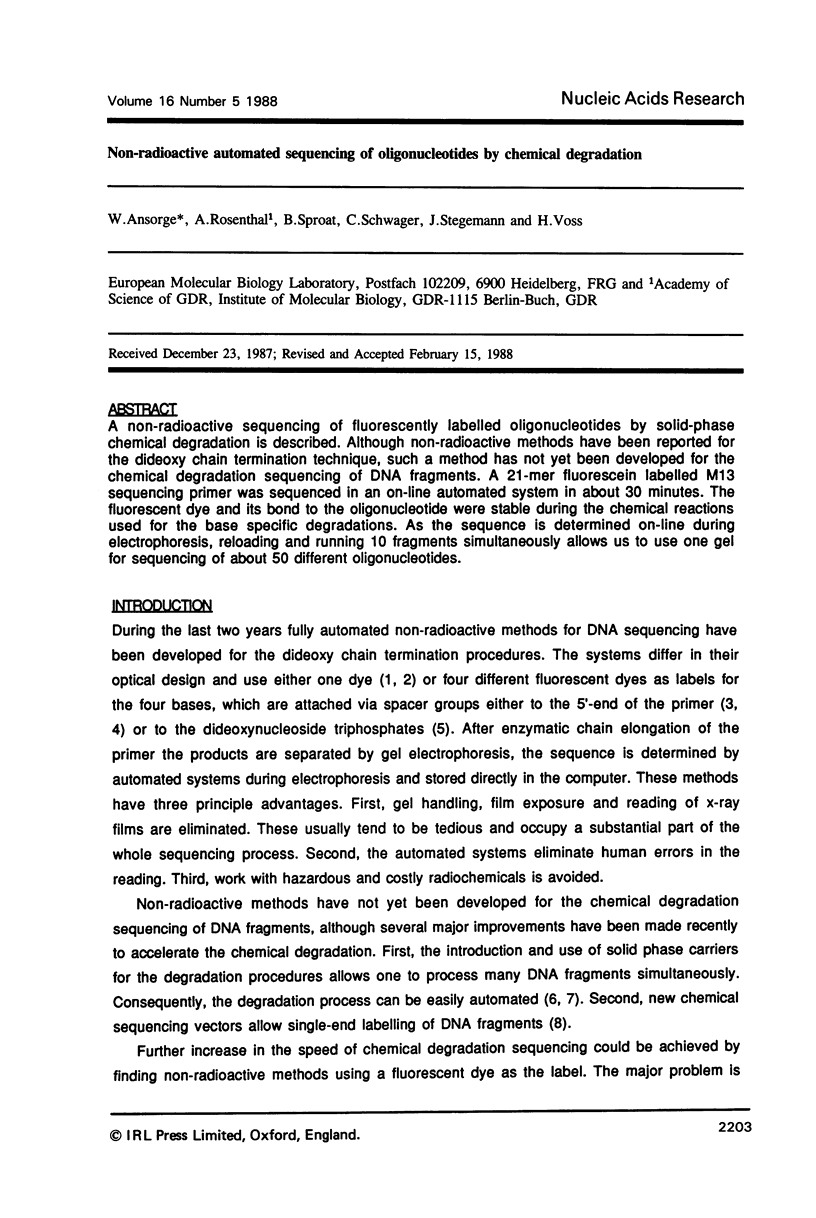Abstract
A non-radioactive sequencing of fluorescently labelled oligonucleotides by solid-phase chemical degradation is described. Although non-radioactive methods have been reported for the dideoxy chain termination technique, such a method has not yet been developed for the chemical degradation sequencing of DNA fragments. A 21-mer fluorescein labelled M13 sequencing primer was sequenced in an on-line automated system in about 30 minutes. The fluorescent dye and its bond to the oligonucleotide were stable during the chemical reactions used for the base specific degradations. As the sequence is determined on-line during electrophoresis, reloading and running 10 fragments simultaneously allows us to use one gel for sequencing of about 50 different oligonucleotides.
Full text
PDF



Selected References
These references are in PubMed. This may not be the complete list of references from this article.
- Ansorge W., Sproat B. S., Stegemann J., Schwager C. A non-radioactive automated method for DNA sequence determination. J Biochem Biophys Methods. 1986 Dec;13(6):315–323. doi: 10.1016/0165-022x(86)90038-2. [DOI] [PubMed] [Google Scholar]
- Ansorge W., Sproat B., Stegemann J., Schwager C., Zenke M. Automated DNA sequencing: ultrasensitive detection of fluorescent bands during electrophoresis. Nucleic Acids Res. 1987 Jun 11;15(11):4593–4602. doi: 10.1093/nar/15.11.4593. [DOI] [PMC free article] [PubMed] [Google Scholar]
- Kristensen T., Voss H., Ansorge W. A simple and rapid preparation of M13 sequencing templates for manual and automated dideoxy sequencing. Nucleic Acids Res. 1987 Jul 24;15(14):5507–5516. doi: 10.1093/nar/15.14.5507. [DOI] [PMC free article] [PubMed] [Google Scholar]
- Prober J. M., Trainor G. L., Dam R. J., Hobbs F. W., Robertson C. W., Zagursky R. J., Cocuzza A. J., Jensen M. A., Baumeister K. A system for rapid DNA sequencing with fluorescent chain-terminating dideoxynucleotides. Science. 1987 Oct 16;238(4825):336–341. doi: 10.1126/science.2443975. [DOI] [PubMed] [Google Scholar]
- Rosenthal A., Schwertner S., Hahn V., Hunger H. D. Solid-phase methods for sequencing of nucleic acids I. Simultaneous sequencing of different oligodeoxyribonucleotides using a new, mechanically stable anion-exchange paper. Nucleic Acids Res. 1985 Feb 25;13(4):1173–1184. doi: 10.1093/nar/13.4.1173. [DOI] [PMC free article] [PubMed] [Google Scholar]
- Sinha N. D., Biernat J., McManus J., Köster H. Polymer support oligonucleotide synthesis XVIII: use of beta-cyanoethyl-N,N-dialkylamino-/N-morpholino phosphoramidite of deoxynucleosides for the synthesis of DNA fragments simplifying deprotection and isolation of the final product. Nucleic Acids Res. 1984 Jun 11;12(11):4539–4557. doi: 10.1093/nar/12.11.4539. [DOI] [PMC free article] [PubMed] [Google Scholar]
- Smith L. M., Sanders J. Z., Kaiser R. J., Hughes P., Dodd C., Connell C. R., Heiner C., Kent S. B., Hood L. E. Fluorescence detection in automated DNA sequence analysis. Nature. 1986 Jun 12;321(6071):674–679. doi: 10.1038/321674a0. [DOI] [PubMed] [Google Scholar]


